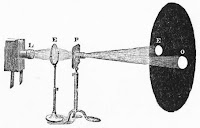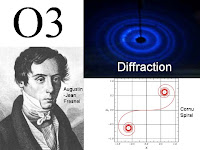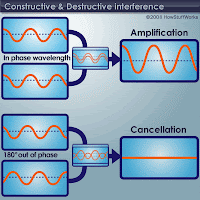
Plane polarized light:
when light travels along a certain direction the vibration takes place in a direction at right angles to the direction of propagation. If the vibration of the ether particles are linear and take place parallel to a plane through the axis of the beam or the direction ofpropagation,light is said to be "plane polarized."
Huygen's theory of Double refraction:

Huygen's theory states that every point on a wave front is a source of secondary wavelets which radiates in all direction from their centres with the speed of the propagation of wave. The wave front is the envelop of the secondary wavelets. If we imagine a point source within the uniaxial Crystal(calcite), the wave front at any time correspnding to the O-rays is a sphere about the point as centre and the wave front corresponding to the E-rays is spheroid because the E-rays have minimum velocity along optic axis and minimum velocity in all direction
perpendicular to the optic axis.
Fraunhofer and Fresnel diffraction:
In the Fraunhofer diffraction, the source of the light and the screen are effectively at infinite distance from the diffracting obstacle or aperture. This is achieved by placing the source and the screen in the focal planes of two lenses. In this case the incident wave frony is plane.

In the Fresnel's diffraction, the source of light and screen on which diffraction pattern is observed are finite distances from obstacle or aperture. In this case no lenses are used. In this case the incident wave front is either spherical or cylindrical.
Spontaneous Emission:

When an atom in an excited state (higher state) E2 jumps to the lower energy state E1 by emitting a photon of frequency v, the process is known as spontaneous emission. If there is an assembly of atoms, the radiation emitted spontaneously by each atom has a random direction and a random phase and is therefore incoherent from one atom to
another.
Stimulated Emission:

When an atom in an excited state E2 interacts with an incident photon of right frequency v and is there by induced to move to ground state E1 by emitting the difference of energy of a photon of same frequency v, the process is known as stimulated emission.
Dichonism:
Some doubly-refracting crystals have the properly of absorbing strongly one of the two refracting rays, while allowing the other to emerge with little loss. This selective absorbtion by the crystal is known as "dichonism". The best example of such crystal is tourmaline.
Interference of light:

When two wave of same frequency travel in approximately the same direction and have a phase difference that remain constant with time, the resultant intensity of light is not distibuted uniformly in space. The non uniform distribution of light intensity due to the superposition of two wave is called interference. At same points the intensity is a maximum,and the interference at these points is called "Constructive interference". At other some point the intensity is minimum, and the interference at these points is called destructive interference.
No comments:
Post a Comment